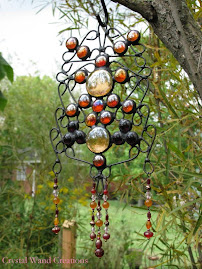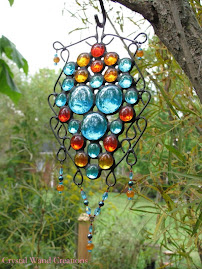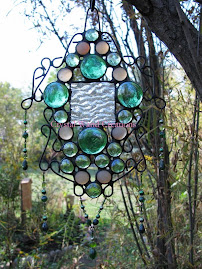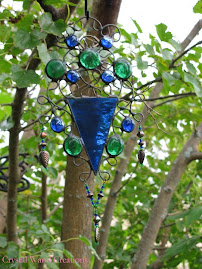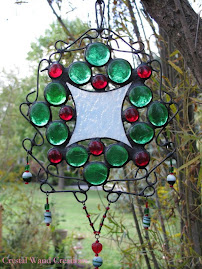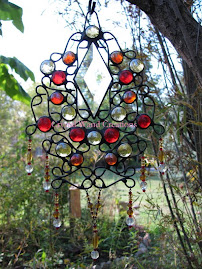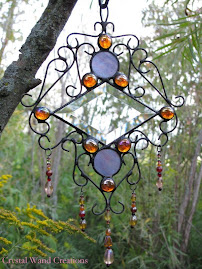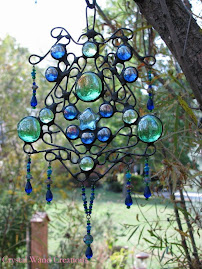 Place your soldering iron in its holder and plug it in. If you have an iron with a built in rheostat you will need to set it around 3 ½ to 4 for soldering solder. For zinc, copper, brass and lead, your rheostat may need a different setting. If your solder doesn’t seem to be melting and flowing like it should you can always adjust it higher.
Place your soldering iron in its holder and plug it in. If you have an iron with a built in rheostat you will need to set it around 3 ½ to 4 for soldering solder. For zinc, copper, brass and lead, your rheostat may need a different setting. If your solder doesn’t seem to be melting and flowing like it should you can always adjust it higher.Make sure your pieces are secured to your board. I find using small pieces of wood with holes drilled in them, or scrap pieces of lead came used as spacers between the glass and the nails helps tremendously, but whatever you choose as long as it is not a nail against your glass is fine. After checking the alignment of all your pieces and verifying everything is in its right place, dip your brush into your small bottle of flux (NOTE: don’t saturate it, just wet it and press it against the side to drain the excess) and brush the flux on a small section of the copper seams. You should notice the copper becomes brighter as the flux cleans it.
Take your solder and unroll about 4 - 5 inches and slightly curve the end in a “J” so that it will easily touch onto your iron. Now holding your solder in your gloved hand and your soldering iron in your ungloved hand turn your iron so the flat edge is vertical (or straight up and down). Holding the iron above the seam to be soldered apply the solder to the iron. When a small drop of solder slides from the iron onto the seam gently set the iron down into that drop and gradually run the iron down the seam while feeding the solder to the iron at the same time. (NOTE: First, when soldering try to keep a small ball of solder on the seam where the iron is sitting. This ball of solder will gently flow down the seam as you feed more solder to it. Secondly, if the solder starts to splatter this means you have added too much flux and need to burn off the excess. DO NOT leave your iron on one spot for too long or your glass will crack! Go over this spot, then let it cool down and come back to it. You may have to reflux lightly when you come back to it.) When you have finished soldering your seam stop feeding your iron with solder (you should do this just before the end of the seam) and gradually pull the iron off the seam at a 90 degree angle. Now go on and do the rest of your piece.
Once you have completely soldered the front then flip the piece over and do the back. For the edges you will need to “tin” all three sides of the copper foil, then bead them. Tinning is applying a thin layer of solder to the copper foil, and beading the edges means turning the piece on its side and lightly applying small drops of solder to the edge. The drops can then be touched lightly with the iron and will flow into a hard rounded edge, or when left as drops they form a beautiful decorative edge. This may take some experimenting, but isn’t too hard to master.
For tinning, apply flux to the outer edge on all three sides. Unroll your solder so that a length of solder is sticking up. Leaving the unrolled solder laying on your table, hold the fluxed piece to be tinned in your gloved hand and take a small amount of solder onto your iron. Run the hot solder along one side of the copper foil adding more solder as needed. Turn the piece and do the same to the back side and the edge. When all three sides are silver from the solder and there is no copper showing you have just completed tinning your piece.
One more note, some people prefer to "tack solder" their pieces first. This is especially helpful when you just can’t find anything to hold your piece together. Tack solder just means fluxing the area to be soldered and applying a small amount of solder to basically “tack” that area together. Place your soldering iron in its holder and plug it in. If you have an iron with a built in rheostat you will need to set it around 3 ½ to 4 for soldering solder. For zinc, copper, brass and lead, your rheostat may need a different setting. If your solder doesn’t seem to be melting and flowing like it should you can always adjust it higher.
Make sure your pieces are secured to your board. I find using small pieces of wood with holes drilled in them helps tremendously, but whatever you choose as long as it is not a nail against your glass is fine. After checking the alignment of all your pieces and verifying everything is in its right place, dip your brush into your small bottle of flux (NOTE: don’t saturate it, just wet it and press it against the side to drain the excess) and brush the flux on a small section of the copper seams. You should notice the copper becomes a bit brighter as the flux cleans it.
Take your solder and unroll about 4 - 5 inches and slightly curve the end in a “J” so that it will easily touch onto your iron. Now holding your solder in your gloved hand and your soldering iron in your ungloved hand turn your iron so the flat edge is vertical (or straight up and down). Holding the iron above the seam to be soldered apply the solder to the iron. When a small drop of solder slides from the iron onto the seam gently set the iron down into that drop and gradually run the iron down the seam while feeding the solder to the iron at the same time. (NOTE: First, when soldering try to keep a small ball of solder on the seam where the iron is sitting. This ball of solder will gently flow down the seam as you feed more solder to it. Secondly, if the solder starts to splatter this means you have added too much flux and need to burn off the excess. DO NOT leave your iron on one spot for too long or your glass will crack! Go over this spot, then let it cool down and come back to it. You may have to reflux lightly when you come back to it.) When you have finished soldering your seam stop feeding your iron with solder (this will usually be done just before the end of the seam) and gradually pull the iron off the seam at a 90 degree angle. Now go on and do the rest of your piece.
Once you have completely soldered the front then flip the piece over and do the back. For the edges you will need to “tin” all three sides of the copper foil, then bead them. Tinning is applying a thin layer of solder to the copper foil, and beading the edges means turning the piece on its side and lightly applying small drops of solder to the edge. The drops can then be touched lightly with the iron and will flow into a hard rounded edge, or when left as drops they form a beautiful decorative edge. This may take some experimenting, but isn’t too hard to master.
For tinning, apply flux to the outer edge on all three sides. Unroll your solder so that the length of solder is sticking up. Leaving the unrolled solder laying on your table, hold the fluxed piece to be tinned in your gloved hand and take a small amount of solder onto your iron. Run the solder along one side of the copper foil adding more solder as needed. Turn the piece and do the same to the back side and the edge. When all three sides are silver from the solder and there is no copper showing you have just completed tinning your piece.
One more note, on those occasions when you just can’t find anything to hold your piece together so you can solder it you may need to “tack solder” it. Tack solder just means fluxing the area to be soldered and applying a small amount of solder to basically “tack” that area together. Some people tack solder their entire piece prior to soldering it. Others only tack solder when they have to. It’s up to you. Experiment. Try a few things. Try it on some things before you use it on your project. The sky is the limit!
Next entry we’ll discuss whether or not to patina your piece and give it that rich black color that everyone loves, and how to apply polish. I’ll also tell you how to make your own hook and how to apply it your piece. In the meantime, here are some videos on soldering stained glass that might help answer some more of your questions: How to Solder 1, 2, 3. Boy we’re almost there, are you as excited as I am? Remember to have fun and keep “kicking ass with glass”!




